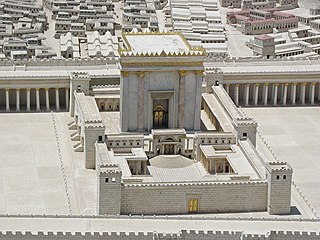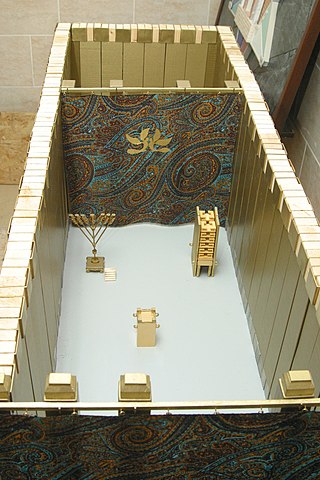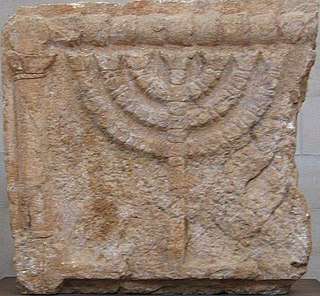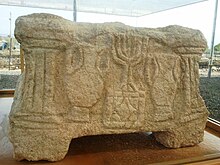
The menorah is a seven-branched candelabrum that is described in the Hebrew Bible and in later ancient sources as having been used in the Tabernacle and in the Temple in Jerusalem.

A synagogue, also called a shul or a temple, is a place of worship for Jews and Samaritans. It has a place for prayer where Jews attend religious services or special ceremonies such as weddings, bar and bat mitzvahs, choir performances, and children's plays. They also have rooms for study, social halls, administrative and charitable offices, classrooms for religious and Hebrew studies, and many places to sit and congregate. They often display commemorative, historic, or modern artwork alongside items of Jewish historical significance or history about the synagogue itself.

The Second Temple, later known as Herod's Temple, was the reconstructed Temple in Jerusalem between c. 516 BCE and 70 CE. Defining the Second Temple period, it stood as a pivotal symbol of Jewish identity and was central to Second Temple Judaism; it was the chief place of worship, ritual sacrifice (korban), and communal gathering for Jews. As such, it attracted Jewish pilgrims from distant lands during the Three Pilgrimage Festivals: Passover, Shavuot, and Sukkot.

The Western Wall, known in the West as the Wailing Wall, and in Islam as the Buraq Wall, is a portion of ancient limestone wall in the Old City of Jerusalem that forms part of the larger retaining wall of the hill known to Jews and Christians as the Temple Mount. Just over half the wall's total height, including its 17 courses located below street level, dates from the end of the Second Temple period, and is believed to have been begun by Herod the Great. The very large stone blocks of the lower courses are Herodian, the courses of medium-sized stones above them were added during the Umayyad period, while the small stones of the uppermost courses are of more recent date, especially from the Ottoman period.

The Arch of Titus is a 1st-century AD honorific arch, located on the Via Sacra, Rome, just to the south-east of the Roman Forum. It was constructed in c. AD 81 by Emperor Domitian shortly after the death of his older brother Titus to commemorate Titus's official deification or consecratio and the victory of Titus together with their father, Vespasian, over the Jewish rebellion in Judaea.

Magdala was an ancient Jewish city on the shore of the Sea of Galilee, 5 km north of Tiberias. In the Babylonian Talmud it is known as Magdala Nunayya, and which some historical geographers think may refer to Tarichaea, literally: "the place of processing fish." It is believed to be the birthplace of Mary Magdalene. Until the 1948 Arab–Israeli War, a small Arab village, al-Majdal, stood at the site of ancient Magdala. The Israeli municipality of Migdal now extends into the area.

The Holy of Holies is a term in the Hebrew Bible that refers to the inner sanctuary of the Tabernacle, where the Shekhinah appeared. According to Hebrew tradition, the area was defined by four pillars that held up the veil of the covering, under which the Ark of the Covenant was held above the floor. According to the Hebrew Bible, the Ark contained the Ten Commandments, which were given by God to Moses on Mount Sinai. The first Temple in Jerusalem, called Solomon's Temple, was said to have been built by King Solomon to keep the Ark.

A Torah ark refers to an ornamental chamber in the synagogue that houses the Torah scrolls.

Synagogue architecture often follows styles in vogue at the place and time of construction. There is no set blueprint for synagogues and the architectural shapes and interior designs of synagogues vary greatly. According to tradition, the Shekhinah or divine presence can be found wherever there is a minyan, a quorum, of ten. A synagogue always contains an Torah ark where the Torah scrolls are kept, called the aron qodesh by Ashkenazi Jews and the hekhal by Sephardic Jews.

Migdal is a town in the Northern District of Israel. It was founded in 1910, and granted local council status in 1949. In 2022 it had a population of 2,031. Migdal is located near Ginosar, and about 8 km north of Tiberias. It has a shoreline on the Sea of Galilee, including the Tamar, Ilanot and Arbel beaches.

The Upper Galilee is a geographical region located in northern Israel. Part of the larger Galilee region, it is characterized by its higher elevations and mountainous terrain. The term "Upper Galilee" is ancient, and has been in use since the end of the Second Temple period. From a political perspective, the Upper Galilee is situated within the administrative boundaries of the Northern District.

The Włodawa Synagogue in Włodawa, Poland is an architectural complex consisting of two historic synagogues and a Jewish administrative building, now preserved as a museum. The complex includes the Włodawa Great Synagogue of 1764–74, the late 18th century Small Synagogue, and the 1928 community building. It is "one of the best-preserved" synagogues in Poland.
Beth Alpha is a sixth-century CE synagogue located at the foot of the northern slopes of the Gilboa mountains near Beit She'an, Israel. It is now part of Bet Alfa Synagogue National Park and managed by the Israel Nature and Parks Authority.

Steven Fine is a historian specializing in 'Judaism in the Greco-Roman World' and a professor at Yeshiva University.

Tzippori Synagogue is an ancient synagogue discovered in Sepphoris, a Roman-era Jewish city in the Galilee, now an archaeological site and a national park in Israel.

The Migdal Synagogue or Magdala Synagogue is the name used for the first of two ancient synagogues discovered at the ancient city of Magdala in Israel, close to the shore of the Sea of Galilee. Both synagogues were in use in the Second Temple period, which places them among the oldest synagogues found in Israel.

Ancient synagogues in Palestine refers to synagogues and their remains in the Palestine region, built by the Jewish and Samaritan communities from the time of the Hasmonean dynasty during the Late Hellenistic period, to the Late Byzantine period.

Shikhin, known in Greek as Asochis, was an ancient Jewish village in Galilee which was abandoned in the fourth century CE. It was situated right next to the regional capital, Sepphoris, and its ruins have been discovered about 8 kilometres (5.0 mi) northwest of Nazareth. As of May 2012, the site is under excavation. So far, evidence of extensive pottery work and a synagogue have been uncovered.

Bersabe, also known as Beersheba of Galilee, was a Second Temple period Jewish village located near the town of Kefar Hananya which marked the boundary between the Upper Galilee and the Lower Galilee, as described by Josephus, with Upper Galilee stretching from Bersabe in the Beit HaKerem Valley to Baca (Peki'in) in the north. Bersabe was one of several towns and villages of Galilee fortified by Josephus during the First Jewish–Roman War, being one of the most defensible positions and where insurgents from across Galilee had taken up refuge against the Imperial Roman army when the surrounding countryside was plundered.

Ancient Jewish art, is art created by Jews in both the Land of Israel and in the Diaspora prior to the Middle Ages. It features symbolic or figurative motifs often influenced by biblical themes, religious symbols, and the dominant cultures of the time, including Egyptian, Hellenistic, and Roman art.





















